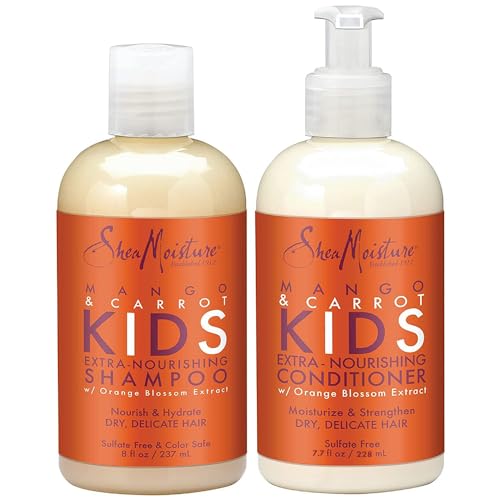
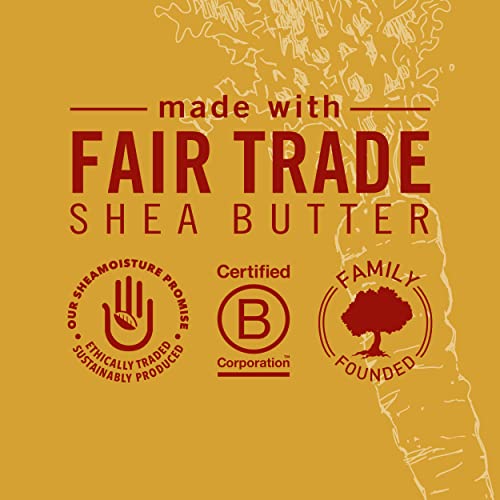
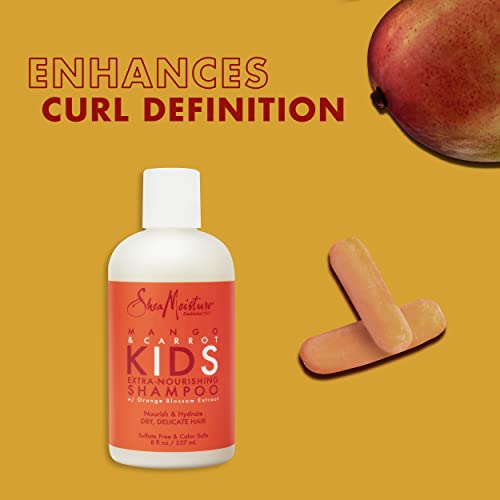
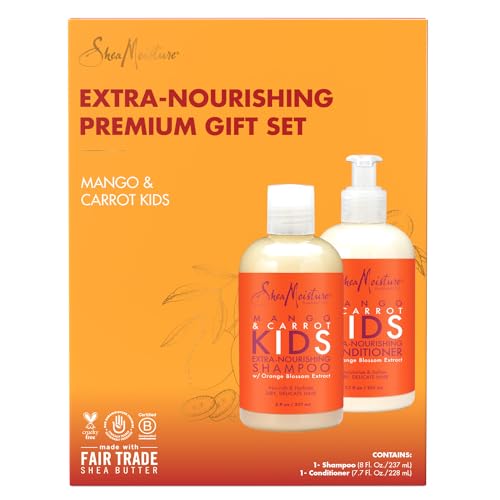
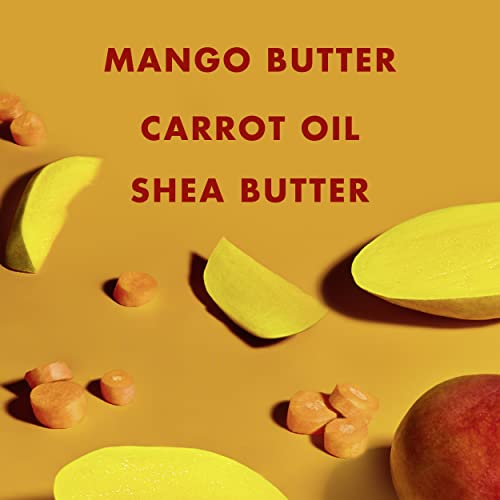
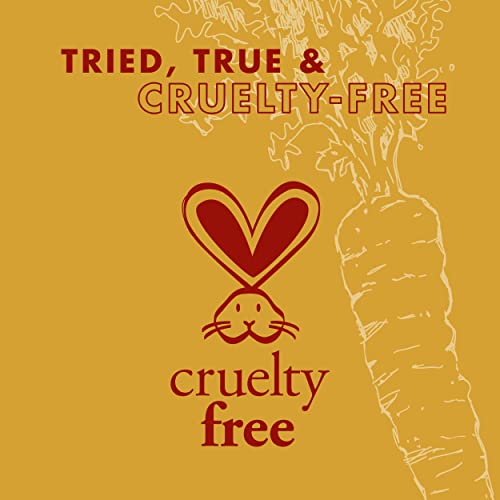
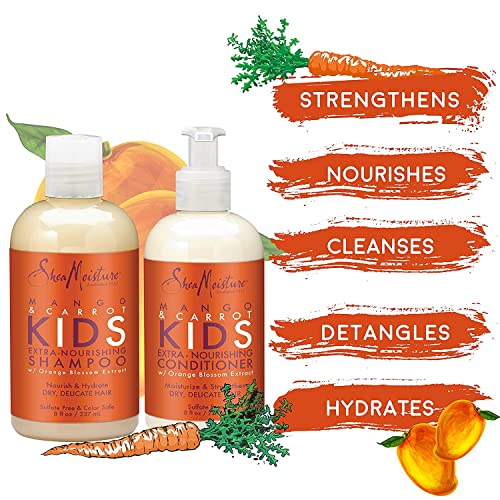
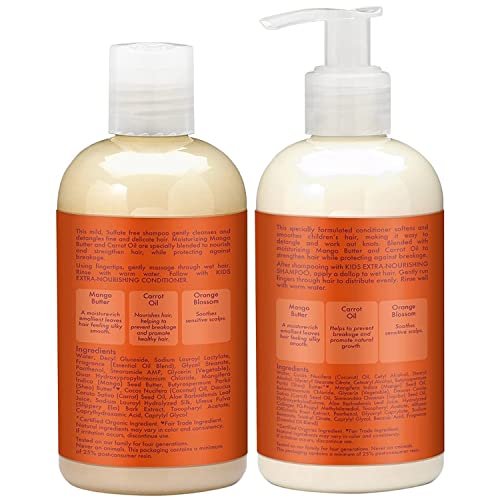
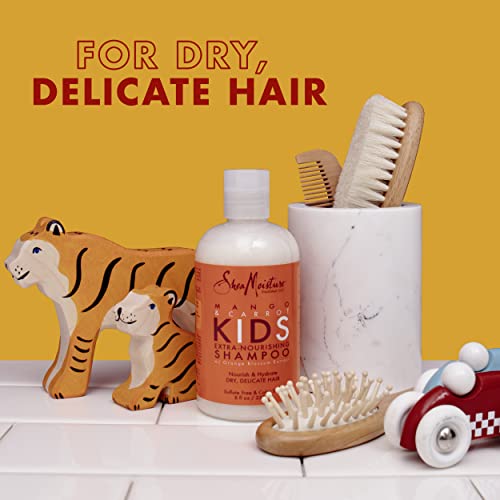
Shea Moisture Kids Shampoo & Conditioner Set - Extra-Nourishing, Organic Ingredients - 8oz & 7.7oz


Glycerin
Medium RiskGlycerin (also called glycerol) is a naturally occurring compound commonly used in personal care and cosmetic products. It functions as a humectant, attracting moisture to the skin, and is also utilized as a solvent and emollient to enhance product texture and stability.
Sustai Insights
Glycerin is valued for its effective moisturizing properties and biodegradability, making it a widely accepted ingredient in formulations. It poses low health risks, including low concerns for carcinogenicity and allergies. However, moderate use restrictions exist due to regulatory guidelines. While glycerin does not significantly contribute to environmental pollution, its production process should be ethically sourced. Overall, glycerin holds a medium risk level, emphasizing the importance of safe usage practices and considering sustainable alternatives.
Tocopheryl Acetate
Medium RiskTocopheryl acetate is a chemical compound that serves primarily as a form of Vitamin E. It is used in cosmetic and personal care products for its antioxidant properties and to enhance skin stability and moisture.
Sustai Insights
Tocopheryl acetate is valued for its functional benefits, including acting as an antioxidant and skin conditioning agent. It is generally considered to have low carcinogenicity and reproductive toxicity risk, although it poses a moderate concern for allergies. Environmental risks are minimal, with no significant pollutant or bioaccumulation potential noted. Regulatory bodies have not imposed significant restrictions. Safe usage practices should be followed, particularly regarding enhanced skin absorption. Alternatives like natural Vitamin E may provide similar benefits with potentially lower allergenic properties. Overall, this ingredient presents a medium risk assessment.
Stearamide Amp
Low RiskStearamide AMP is a chemical compound primarily used in various cosmetic and personal care products as an emulsifier and thickening agent. It functions by enhancing the texture and stability of formulations, contributing to the overall performance of the product without imparting any specific benefits or drawbacks.
Sustai Insights
Stearamide AMP serves as an emulsifier and thickening agent, contributing to product stability and texture. It is not associated with significant health risks, including low concerns for carcinogenicity, allergies, or reproductive toxicity. Environmentally, it poses minimal risks as it is not a known pollutant or bioaccumulative. Regulatory bodies do not issue any warnings or restrictions regarding its use, designating it as low risk overall. Safe usage practices are recommended, and alternatives may include more sustainable emulsifiers if desired.
Mangifera Indica (Mango) Seed Butter
Low RiskMangifera indica (mango) seed butter is a fat extracted from the seeds of the mango fruit. It is commonly used in cosmetic formulations for its emollient and moisturizing properties, providing a smooth texture and enhancing product stability.
Sustai Insights
Mango seed butter offers functional benefits such as effective moisturization and skin conditioning, derived from its fatty acid profile. It is considered low risk regarding health concerns, with minimal allergenic potential and no significant environmental hazards. Regulatory agencies have not imposed restrictions on its use. Overall, the ingredient is assessed as low risk, making it a suitable option for various cosmetic products. Alternatives include other plant-based butters like shea or cocoa butter for similar properties.
Glycol Stearate
Low RiskGlycol stearate is composed of ethylene glycol and stearic acid. It serves primarily as an emulsifier and thickener in cosmetic formulations, helping to stabilize and enhance the texture of products.
Sustai Insights
Glycol stearate exhibits functional benefits as an effective emulsifier, improving product stability and texture. It is generally recognized as having low health risks, with no significant concerns regarding carcinogenicity, allergies, or reproductive toxicity. Environmentally, it poses low risks with no significant pollutant potential or bioaccumulation. Regulatory agencies have not imposed significant restrictions on its use in cosmetics. Overall, it is assessed as low risk, making it a suitable ingredient in formulations. For those seeking alternatives, other natural emulsifiers may be considered.
Guar Hydroxypropyltrimonium Chloride
Low RiskGuar hydroxypropyltrimonium chloride is a quaternary ammonium compound derived from guar gum, primarily used as a conditioning agent in cosmetic products. It enhances the texture and feel of hair and skin formulations, providing moisture retention and improved manageability.
Sustai Insights
This ingredient offers functional benefits as a conditioning agent, improving the texture and moisture retention in formulations. It is considered low risk regarding health effects, with minimal concerns for carcinogenicity, allergies, or reproductive toxicity. Environmental risks are also low, as it does not accumulate significantly in ecosystems. Regulatory bodies have not imposed significant restrictions. Safe usage practices should be followed, but overall, this ingredient is assessed as low risk, with no immediate concerns regarding alternatives.
Sodium Lauroyl Hydrolyzed Silk
Low RiskSodium lauroyl hydrolyzed silk is a sodium salt of hydrolyzed silk protein, used primarily in cosmetic and personal care products for its emollient properties. It helps to improve the texture and moisture retention of formulations, contributing to skin and hair conditioning.
Sustai Insights
Sodium lauroyl hydrolyzed silk offers functional benefits such as enhanced moisture retention and improved texture in formulations. It is considered low risk for known health concerns, including carcinogenicity and allergenic potential. Environmental risks are also low, with no evidence of bioaccumulation or significant pollution. Regulatory status is clear, with no current restrictions. Safe usage practices should be followed, and while alternatives exist, they may not replicate the same conditioning properties. Overall, the assessment indicates a low risk associated with this ingredient.
Daucus Carota Sativa (Carrot) Seed Oil
Low RiskDaucus carota sativa (carrot) seed oil is an oil extracted from the seeds of the carrot plant. It is commonly used in cosmetic formulations for its potential emollient and moisturizing properties. The oil is rich in carotenoids and fatty acids, contributing to its functional role in personal care products.
Sustai Insights
Carrot seed oil offers several functional benefits, including moisturizing properties and potential skin rejuvenation effects due to its carotenoid content. It is generally recognized as safe, with low concerns for cancer, allergies, or reproductive toxicity, and is not subject to significant regulatory restrictions. Environmental risks are minimal, with no noted pollutant or bioaccumulation issues. Overall, the ingredient is considered low risk. For those seeking alternatives, other plant-based oils with similar moisturizing properties may be recommended.
Octanohydroxamic Acid
Low RiskOctanohydroxamic acid is a cosmetic ingredient primarily used for its functional properties, including acting as a preservative and stabilizer in various formulations. It is recognized for its ability to enhance product efficacy while maintaining product integrity over time.
Sustai Insights
Octanohydroxamic acid is valued for its effective preservative qualities and low environmental impact, being biodegradable and sustainably sourced. However, it is associated with low risks of irritation and moderate allergic potential, though evidence suggests minimal carcinogenicity and reproductive toxicity. Regulatory advisories recommend cautious use due to irritation risks. Overall, the ingredient presents a low risk profile when used appropriately, making it a suitable choice in cosmetic formulations.
Ulmus Fulva (Slippery Elm) Bark Extract
Low RiskUlmus fulva (slippery elm) bark extract is derived from the inner bark of the slippery elm tree. It is primarily used for its soothing properties in various products, particularly those aimed at relieving irritation and inflammation in the skin or mucous membranes.
Sustai Insights
Ulmus fulva bark extract offers functional benefits such as skin soothing and anti-inflammatory effects, contributing positively to product efficacy. It is considered low risk for health hazards, including carcinogenicity, allergenic potential, and reproductive toxicity. Environmental concerns are minimal, with no significant pollutant or bioaccumulation potential. Regulatory bodies have not issued restrictions on this ingredient. Safe usage practices include moderation in application, and while alternatives exist, this extract is generally regarded as a low-risk option.
Decyl Glucoside
Low RiskDecyl glucoside is a glucose-based surfactant derived from natural sources, primarily used as a mild cleansing agent in personal care products. It effectively reduces surface tension, allowing for improved mixing of ingredients and enhanced cleansing properties without stripping natural oils from the skin.
Sustai Insights
Decyl glucoside offers functional benefits as a non-ionic surfactant, making it suitable for sensitive skin formulations. It is biodegradable and derived from renewable resources, supporting sustainability. Health risks are primarily low, with minimal concerns regarding irritation and allergies. Environmental risks are low, as it does not significantly contribute to pollution or bioaccumulation. Regulatory status is generally favorable, with low restrictions noted. Overall, decyl glucoside presents a low risk for use in consumer products, making it a suitable choice for gentle formulations.
Sodium Lauroyl Lactylate
Low RiskSodium lauroyl lactylate is a sodium salt of lauric acid and lactyl lactate, primarily used in cosmetic formulations as an emulsifier and skin conditioning agent. It helps to enhance the texture and stability of products while also promoting skin feel.
Sustai Insights
Sodium lauroyl lactylate is valued for its emulsifying properties, improving product texture and stability. It is considered biodegradable and sustainably sourced, contributing to eco-friendliness. Health risks are low, with minimal concerns regarding carcinogenicity, allergenic potential, and reproductive toxicity. Environmental risks are also low, with no significant bioaccumulation or pollution potential identified. Regulatory bodies have not imposed restrictions on its use. Overall, this ingredient presents a low risk profile, making it a suitable choice for cosmetic formulations.
Water
Low RiskWater is a clear, colorless liquid essential for various biological processes. It serves as a solvent in formulations, facilitating the dissolution of other ingredients and enhancing product texture and application. Additionally, water plays a crucial role in hydration and is a key component in many cosmetic and personal care products.
Sustai Insights
Water is an effective solvent and hydrator, contributing to the texture and efficacy of formulations. It is biodegradable and generally regarded as safe, with low concerns regarding carcinogenicity, allergies, and reproductive toxicity. However, excessive water usage can lead to environmental concerns, particularly regarding resource depletion. Regulatory bodies do not impose restrictions on water use in cosmetics. Overall, the risks associated with water are low, making it a safe and essential ingredient.
Panthenol
Low RiskPanthenol, a derivative of vitamin B5, is commonly used in cosmetic formulations for its moisturizing and skin-conditioning properties. It acts as a humectant, helping to retain moisture in the skin and hair, thereby improving hydration and texture.
Sustai Insights
Panthenol offers functional benefits such as effective hydration and skin conditioning, making it valuable in various cosmetic products. It is considered low risk regarding health impacts, with minimal concerns about carcinogenicity, allergies, or reproductive toxicity. Environmental risks are also low, with no significant pollutant or bioaccumulation potential. Regulatory bodies have not imposed restrictions on its use. Safe usage practices include adhering to recommended concentrations. Alternatives like glycerin may provide similar moisturizing benefits, but overall, panthenol is assessed as a low-risk ingredient.
Caprylyl Glycol
Low RiskCaprylyl glycol (1,2-octanediol) is a multifunctional cosmetic ingredient primarily used as a skin-conditioning agent and preservative. It is derived from caprylic acid, a fatty acid found in coconut oil, and is commonly included in personal care products for its moisturizing properties.
Sustai Insights
Caprylyl glycol offers functional benefits such as acting as an effective humectant and preservative, enhancing skin hydration and product stability. It is considered to have low health risks, with no significant concerns regarding carcinogenicity, allergies, or reproductive toxicity. Environmentally, it poses minimal risks, being non-bioaccumulative and not linked to pollution. Regulatory assessments affirm its safety, with no major advisories against its use. Overall, the ingredient is assessed to have a low risk, making it a suitable choice in cosmetic formulations.
Cocos Nucifera (Coconut) Oil
Low RiskCocos Nucifera (Coconut) Oil is derived from the kernels of the coconut palm. It is primarily used in cosmetic formulations for its emollient and moisturizing properties, making it suitable for skin and hair care products.
Sustai Insights
Coconut oil serves as an effective moisturizer and emollient, promoting skin hydration and softness. It is sustainably sourced and biodegradable. Health risks are minimal, with low concerns regarding carcinogenicity, allergens, and reproductive toxicity. Environmental impact is also low, as it does not contribute significantly to pollution or bioaccumulation. Regulatory bodies have not issued restrictions on its use. Overall, coconut oil presents a low risk for health and environmental concerns, making it a safe ingredient in cosmetic products.
Butyrospermum Parkii (Shea) Butter
Low RiskButyrospermum parkii (shea) butter is a vegetable fat derived from the nuts of the shea tree. It is commonly used in cosmetic formulations for its emollient properties, providing moisture and improving skin texture. Additionally, shea butter is known for its ability to enhance the stability of products and deliver a creamy texture.
Sustai Insights
Shea butter offers functional benefits as an effective moisturizer, enhancing skin barrier function and texture. It is sustainably sourced and biodegradable, contributing to eco-friendliness. Health-wise, it is associated with low risks for carcinogenicity, allergies, and reproductive toxicity. Environmental impacts are minimal, with no significant pollutant potential identified. Regulatory assessments indicate no current restrictions. Overall, the ingredient presents a low risk, making it a favorable choice in cosmetic formulations.
Aloe Barbadensis (Aloe Vera) Leaf Juice
Low RiskAloe barbadensis (aloe vera) leaf juice is derived from the succulent aloe vera plant, known for its hydrating and soothing properties. It is commonly used in cosmetic formulations for its moisturizing effects and is often included in products aimed at skin care and healing.
Sustai Insights
Aloe vera leaf juice offers functional benefits as a moisturizer and skin soothing agent, while being sustainably sourced and biodegradable. Health risks are low, with minimal concerns regarding carcinogenicity, allergies, and reproductive toxicity. Environmental impact is also low, with no significant pollutants identified. Regulatory agencies impose few restrictions. Overall, the ingredient poses a low risk, making it a favorable choice in cosmetic formulations.
Stearamide Amp
Low RiskStearamide AMP is a chemical compound primarily used in various cosmetic and personal care products as an emulsifier and thickening agent. It functions by enhancing the texture and stability of formulations, contributing to the overall performance of the product without imparting any specific benefits or drawbacks.
Sustai Insights
Stearamide AMP serves as an emulsifier and thickening agent, contributing to product stability and texture. It is not associated with significant health risks, including low concerns for carcinogenicity, allergies, or reproductive toxicity. Environmentally, it poses minimal risks as it is not a known pollutant or bioaccumulative. Regulatory bodies do not issue any warnings or restrictions regarding its use, designating it as low risk overall. Safe usage practices are recommended, and alternatives may include more sustainable emulsifiers if desired.
Mangifera Indica (Mango) Seed Butter
Low RiskMangifera indica (mango) seed butter is a fat extracted from the seeds of the mango fruit. It is commonly used in cosmetic formulations for its emollient and moisturizing properties, providing a smooth texture and enhancing product stability.
Sustai Insights
Mango seed butter offers functional benefits such as effective moisturization and skin conditioning, derived from its fatty acid profile. It is considered low risk regarding health concerns, with minimal allergenic potential and no significant environmental hazards. Regulatory agencies have not imposed restrictions on its use. Overall, the ingredient is assessed as low risk, making it a suitable option for various cosmetic products. Alternatives include other plant-based butters like shea or cocoa butter for similar properties.
Glycol Stearate
Low RiskGlycol stearate is composed of ethylene glycol and stearic acid. It serves primarily as an emulsifier and thickener in cosmetic formulations, helping to stabilize and enhance the texture of products.
Sustai Insights
Glycol stearate exhibits functional benefits as an effective emulsifier, improving product stability and texture. It is generally recognized as having low health risks, with no significant concerns regarding carcinogenicity, allergies, or reproductive toxicity. Environmentally, it poses low risks with no significant pollutant potential or bioaccumulation. Regulatory agencies have not imposed significant restrictions on its use in cosmetics. Overall, it is assessed as low risk, making it a suitable ingredient in formulations. For those seeking alternatives, other natural emulsifiers may be considered.
Guar Hydroxypropyltrimonium Chloride
Low RiskGuar hydroxypropyltrimonium chloride is a quaternary ammonium compound derived from guar gum, primarily used as a conditioning agent in cosmetic products. It enhances the texture and feel of hair and skin formulations, providing moisture retention and improved manageability.
Sustai Insights
This ingredient offers functional benefits as a conditioning agent, improving the texture and moisture retention in formulations. It is considered low risk regarding health effects, with minimal concerns for carcinogenicity, allergies, or reproductive toxicity. Environmental risks are also low, as it does not accumulate significantly in ecosystems. Regulatory bodies have not imposed significant restrictions. Safe usage practices should be followed, but overall, this ingredient is assessed as low risk, with no immediate concerns regarding alternatives.
Sodium Lauroyl Hydrolyzed Silk
Low RiskSodium lauroyl hydrolyzed silk is a sodium salt of hydrolyzed silk protein, used primarily in cosmetic and personal care products for its emollient properties. It helps to improve the texture and moisture retention of formulations, contributing to skin and hair conditioning.
Sustai Insights
Sodium lauroyl hydrolyzed silk offers functional benefits such as enhanced moisture retention and improved texture in formulations. It is considered low risk for known health concerns, including carcinogenicity and allergenic potential. Environmental risks are also low, with no evidence of bioaccumulation or significant pollution. Regulatory status is clear, with no current restrictions. Safe usage practices should be followed, and while alternatives exist, they may not replicate the same conditioning properties. Overall, the assessment indicates a low risk associated with this ingredient.
Daucus Carota Sativa (Carrot) Seed Oil
Low RiskDaucus carota sativa (carrot) seed oil is an oil extracted from the seeds of the carrot plant. It is commonly used in cosmetic formulations for its potential emollient and moisturizing properties. The oil is rich in carotenoids and fatty acids, contributing to its functional role in personal care products.
Sustai Insights
Carrot seed oil offers several functional benefits, including moisturizing properties and potential skin rejuvenation effects due to its carotenoid content. It is generally recognized as safe, with low concerns for cancer, allergies, or reproductive toxicity, and is not subject to significant regulatory restrictions. Environmental risks are minimal, with no noted pollutant or bioaccumulation issues. Overall, the ingredient is considered low risk. For those seeking alternatives, other plant-based oils with similar moisturizing properties may be recommended.
Octanohydroxamic Acid
Low RiskOctanohydroxamic acid is a cosmetic ingredient primarily used for its functional properties, including acting as a preservative and stabilizer in various formulations. It is recognized for its ability to enhance product efficacy while maintaining product integrity over time.
Sustai Insights
Octanohydroxamic acid is valued for its effective preservative qualities and low environmental impact, being biodegradable and sustainably sourced. However, it is associated with low risks of irritation and moderate allergic potential, though evidence suggests minimal carcinogenicity and reproductive toxicity. Regulatory advisories recommend cautious use due to irritation risks. Overall, the ingredient presents a low risk profile when used appropriately, making it a suitable choice in cosmetic formulations.
Ulmus Fulva (Slippery Elm) Bark Extract
Low RiskUlmus fulva (slippery elm) bark extract is derived from the inner bark of the slippery elm tree. It is primarily used for its soothing properties in various products, particularly those aimed at relieving irritation and inflammation in the skin or mucous membranes.
Sustai Insights
Ulmus fulva bark extract offers functional benefits such as skin soothing and anti-inflammatory effects, contributing positively to product efficacy. It is considered low risk for health hazards, including carcinogenicity, allergenic potential, and reproductive toxicity. Environmental concerns are minimal, with no significant pollutant or bioaccumulation potential. Regulatory bodies have not issued restrictions on this ingredient. Safe usage practices include moderation in application, and while alternatives exist, this extract is generally regarded as a low-risk option.
Decyl Glucoside
Low RiskDecyl glucoside is a glucose-based surfactant derived from natural sources, primarily used as a mild cleansing agent in personal care products. It effectively reduces surface tension, allowing for improved mixing of ingredients and enhanced cleansing properties without stripping natural oils from the skin.
Sustai Insights
Decyl glucoside offers functional benefits as a non-ionic surfactant, making it suitable for sensitive skin formulations. It is biodegradable and derived from renewable resources, supporting sustainability. Health risks are primarily low, with minimal concerns regarding irritation and allergies. Environmental risks are low, as it does not significantly contribute to pollution or bioaccumulation. Regulatory status is generally favorable, with low restrictions noted. Overall, decyl glucoside presents a low risk for use in consumer products, making it a suitable choice for gentle formulations.
Sodium Lauroyl Lactylate
Low RiskSodium lauroyl lactylate is a sodium salt of lauric acid and lactyl lactate, primarily used in cosmetic formulations as an emulsifier and skin conditioning agent. It helps to enhance the texture and stability of products while also promoting skin feel.
Sustai Insights
Sodium lauroyl lactylate is valued for its emulsifying properties, improving product texture and stability. It is considered biodegradable and sustainably sourced, contributing to eco-friendliness. Health risks are low, with minimal concerns regarding carcinogenicity, allergenic potential, and reproductive toxicity. Environmental risks are also low, with no significant bioaccumulation or pollution potential identified. Regulatory bodies have not imposed restrictions on its use. Overall, this ingredient presents a low risk profile, making it a suitable choice for cosmetic formulations.
Water
Low RiskWater is a clear, colorless liquid essential for various biological processes. It serves as a solvent in formulations, facilitating the dissolution of other ingredients and enhancing product texture and application. Additionally, water plays a crucial role in hydration and is a key component in many cosmetic and personal care products.
Sustai Insights
Water is an effective solvent and hydrator, contributing to the texture and efficacy of formulations. It is biodegradable and generally regarded as safe, with low concerns regarding carcinogenicity, allergies, and reproductive toxicity. However, excessive water usage can lead to environmental concerns, particularly regarding resource depletion. Regulatory bodies do not impose restrictions on water use in cosmetics. Overall, the risks associated with water are low, making it a safe and essential ingredient.
Glycerin
Medium RiskGlycerin (also called glycerol) is a naturally occurring compound commonly used in personal care and cosmetic products. It functions as a humectant, attracting moisture to the skin, and is also utilized as a solvent and emollient to enhance product texture and stability.
Sustai Insights
Glycerin is valued for its effective moisturizing properties and biodegradability, making it a widely accepted ingredient in formulations. It poses low health risks, including low concerns for carcinogenicity and allergies. However, moderate use restrictions exist due to regulatory guidelines. While glycerin does not significantly contribute to environmental pollution, its production process should be ethically sourced. Overall, glycerin holds a medium risk level, emphasizing the importance of safe usage practices and considering sustainable alternatives.
Panthenol
Low RiskPanthenol, a derivative of vitamin B5, is commonly used in cosmetic formulations for its moisturizing and skin-conditioning properties. It acts as a humectant, helping to retain moisture in the skin and hair, thereby improving hydration and texture.
Sustai Insights
Panthenol offers functional benefits such as effective hydration and skin conditioning, making it valuable in various cosmetic products. It is considered low risk regarding health impacts, with minimal concerns about carcinogenicity, allergies, or reproductive toxicity. Environmental risks are also low, with no significant pollutant or bioaccumulation potential. Regulatory bodies have not imposed restrictions on its use. Safe usage practices include adhering to recommended concentrations. Alternatives like glycerin may provide similar moisturizing benefits, but overall, panthenol is assessed as a low-risk ingredient.
Caprylyl Glycol
Low RiskCaprylyl glycol (1,2-octanediol) is a multifunctional cosmetic ingredient primarily used as a skin-conditioning agent and preservative. It is derived from caprylic acid, a fatty acid found in coconut oil, and is commonly included in personal care products for its moisturizing properties.
Sustai Insights
Caprylyl glycol offers functional benefits such as acting as an effective humectant and preservative, enhancing skin hydration and product stability. It is considered to have low health risks, with no significant concerns regarding carcinogenicity, allergies, or reproductive toxicity. Environmentally, it poses minimal risks, being non-bioaccumulative and not linked to pollution. Regulatory assessments affirm its safety, with no major advisories against its use. Overall, the ingredient is assessed to have a low risk, making it a suitable choice in cosmetic formulations.
Tocopheryl Acetate
Medium RiskTocopheryl acetate is a chemical compound that serves primarily as a form of Vitamin E. It is used in cosmetic and personal care products for its antioxidant properties and to enhance skin stability and moisture.
Sustai Insights
Tocopheryl acetate is valued for its functional benefits, including acting as an antioxidant and skin conditioning agent. It is generally considered to have low carcinogenicity and reproductive toxicity risk, although it poses a moderate concern for allergies. Environmental risks are minimal, with no significant pollutant or bioaccumulation potential noted. Regulatory bodies have not imposed significant restrictions. Safe usage practices should be followed, particularly regarding enhanced skin absorption. Alternatives like natural Vitamin E may provide similar benefits with potentially lower allergenic properties. Overall, this ingredient presents a medium risk assessment.
Cocos Nucifera (Coconut) Oil
Low RiskCocos Nucifera (Coconut) Oil is derived from the kernels of the coconut palm. It is primarily used in cosmetic formulations for its emollient and moisturizing properties, making it suitable for skin and hair care products.
Sustai Insights
Coconut oil serves as an effective moisturizer and emollient, promoting skin hydration and softness. It is sustainably sourced and biodegradable. Health risks are minimal, with low concerns regarding carcinogenicity, allergens, and reproductive toxicity. Environmental impact is also low, as it does not contribute significantly to pollution or bioaccumulation. Regulatory bodies have not issued restrictions on its use. Overall, coconut oil presents a low risk for health and environmental concerns, making it a safe ingredient in cosmetic products.
Butyrospermum Parkii (Shea) Butter
Low RiskButyrospermum parkii (shea) butter is a vegetable fat derived from the nuts of the shea tree. It is commonly used in cosmetic formulations for its emollient properties, providing moisture and improving skin texture. Additionally, shea butter is known for its ability to enhance the stability of products and deliver a creamy texture.
Sustai Insights
Shea butter offers functional benefits as an effective moisturizer, enhancing skin barrier function and texture. It is sustainably sourced and biodegradable, contributing to eco-friendliness. Health-wise, it is associated with low risks for carcinogenicity, allergies, and reproductive toxicity. Environmental impacts are minimal, with no significant pollutant potential identified. Regulatory assessments indicate no current restrictions. Overall, the ingredient presents a low risk, making it a favorable choice in cosmetic formulations.
Aloe Barbadensis (Aloe Vera) Leaf Juice
Low RiskAloe barbadensis (aloe vera) leaf juice is derived from the succulent aloe vera plant, known for its hydrating and soothing properties. It is commonly used in cosmetic formulations for its moisturizing effects and is often included in products aimed at skin care and healing.
Sustai Insights
Aloe vera leaf juice offers functional benefits as a moisturizer and skin soothing agent, while being sustainably sourced and biodegradable. Health risks are low, with minimal concerns regarding carcinogenicity, allergies, and reproductive toxicity. Environmental impact is also low, with no significant pollutants identified. Regulatory agencies impose few restrictions. Overall, the ingredient poses a low risk, making it a favorable choice in cosmetic formulations.
Experience the gentle power of Shea Moisture's Mango & Carrot Kids Extra-Nourishing Shampoo and Conditioner set. Designed for dry, delicate hair, this nourishing duo delivers essential hydration and vibrant shine while being kind to the environment.
- Extra-Nourishing Formula: Enriched with coconut oil, olive oil, and organic shea butter, this shampoo effectively cleanses while fortifying strands for a healthy look and feel.
- Detangling Made Easy: The conditioner softens and smooths hair, making it a breeze to detangle and manage knots, reducing breakage and promoting healthy growth.
- Moisture-Rich Ingredients: Featuring mango butter and carrot oil, this set provides deep moisture, ensuring hair remains silky and smooth.
- Certified Organic Goodness: Committed to quality, this product is free from parabens, phthalates, and sulfates, ensuring a safe and gentle wash for kids' sensitive skin.
- Eco-Friendly Packaging: Proudly made with a minimum of 25% post-consumer resin, this product reflects a commitment to sustainability while caring for your child and the planet.
Subscribe & Save with Sustai
- Best Price Guarantee: Always enjoy the lowest prices on sustainable home essentials.
- No Surprises: We’ll notify you before shipping. No hidden fees, ever.
- You’re in Charge: Change, pause, or cancel your subscription anytime with ease.
- Eco-Friendly Deliveries: Our grouped shipments mean less packaging and lower emissions.
Join us on a sustainable journey. Special offers for a limited time! Prices and promotions may change.
Recommended Products
Experience the gentle power of Shea Moisture's Mango & Carrot Kids Extra-Nourishing Shampoo and Conditioner set. Designed for dry, delicate hair, this nourishing duo delivers essential hydration and vibrant shine while being kind to the environment.
- Extra-Nourishing Formula: Enriched with coconut oil, olive oil, and organic shea butter, this shampoo effectively cleanses while fortifying strands for a healthy look and feel.
- Detangling Made Easy: The conditioner softens and smooths hair, making it a breeze to detangle and manage knots, reducing breakage and promoting healthy growth.
- Moisture-Rich Ingredients: Featuring mango butter and carrot oil, this set provides deep moisture, ensuring hair remains silky and smooth.
- Certified Organic Goodness: Committed to quality, this product is free from parabens, phthalates, and sulfates, ensuring a safe and gentle wash for kids' sensitive skin.
- Eco-Friendly Packaging: Proudly made with a minimum of 25% post-consumer resin, this product reflects a commitment to sustainability while caring for your child and the planet.

You can have at most 2 Sustainable Steals products in your cart
Customer Reviews
Customers’ View
Customers appreciate the gentle yet effective cleansing properties of Shea Moisture's Mango & Carrot Kids Shampoo and Conditioner, which leave children's hair soft and manageable. Many parents note that it simplifies their morning routines, with one user highlighting how it makes tangled, curly hair much easier to brush. Additionally, the product is praised for its pleasant scent and the ability to nourish dry hair without causing irritation, making it suitable for sensitive skin. The formulation's eco-friendly aspects, including being free from harmful chemicals and cruelty-free, resonate positively with health-conscious families. Overall, this product is seen as a valuable addition to eco-friendly and child-friendly bath routines.
AI-generated from the text of customer reviewsThis product is rated 4.8 of 5.0 stars.
It has received 21 reviews.




